|
February
2021
Contents
Monthly Meeting
Upcoming Field Trips
President's Message
Bird of the Month
Special Articles
Field Trip Reports
FEBRUARY MEETING:
February UCB Meeting:
Wednesday, Feb 10 at 7pm via
Zoom
The meeting this coming month will be:
Wednesday, February 10, 2021 7:00pm
Virtual Zoom Meeting
Robert Parsons will be our guest speaker and his presentation is titled:
“Birding the Wilds of Papua New Guinea—-an Adventure Never to Forget”.
We hope you all can join us virtually for this fun meeting!
Machelle
Johnson is inviting you to a scheduled Zoom meeting.
Topic: Utah County Birders
Time: Feb 10, 2021 07:00 PM Mountain Time (US and Canada)
Join Zoom Meeting
https://byu.zoom.us/j/95565731917?pwd=RkpSVExHeEVQNlZ1UGpzRXlVdXlFQT09
Meeting ID: 955 6573 1917
Passcode: 252558
One tap mobile
+16699006833,,95565731917# US (San Jose)
+12532158782,,95565731917# US (Tacoma)
Dial by your location
+1 669 900 6833 US (San Jose)
+1 253 215 8782 US (Tacoma)
+1 346 248 7799 US (Houston)
+1 646 558 8656 US (New York)
+1 301 715 8592 US (Washington DC)
+1 312 626 6799 US (Chicago)
Meeting ID: 955 6573 1917
Find your local number: https://byu.zoom.us/u/acqdOCjv9t
Join by SIP
95565731917@zoomcrc.com
FIELD TRIPS:
|
OXO
OXO
February 14th:
February 14th
For the love of birds let's try to get out on
February
14th Valentines Day
and see 14 different species!!
Happy
Valentines Day!!
VVV
V
|
|
President's Message -
February 2021
by Machelle Johnson
It takes time and effort to become really good at birding.
Of course you don't have to be 'really good' at birding to enjoy it! Birding can
be watching birds at your bird feeder to traveling the world to see birds, or
being an expert on birds. Birding is for everyone at all levels.
|
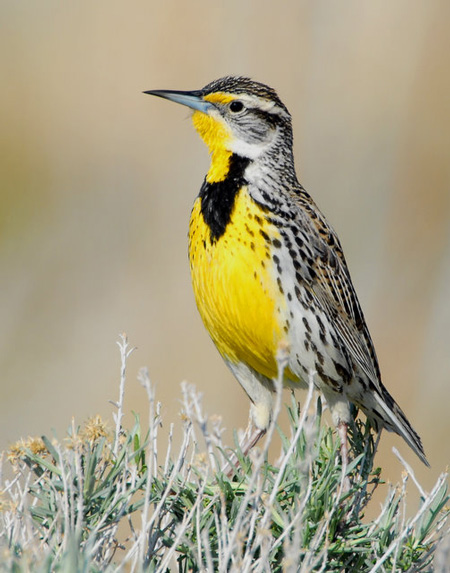
Western Meadowlark
by Paul Higgins
©Paul Higgins |
I got started in birding in my junior year of high school at Orem High. Al Davis
and Cheryl Lewis taught a 3 hour per day block class called Unified Studies. One
of the units we studied was Birds. I bought a Golden Field Guide and I read it
like a novel. I really enjoyed learning about bird identification. At first I
just wanted to know what the bird was. But the more I went out the more I wanted
to know about them. I would say the Western Meadowlark was my 'hook bird'. That
song, I still love it! I was an avid birder for about 10 years, but that was
mostly just me and my sister going down to the lake or other local places for
birding. I only say 'avid' because it was something I was really interested in
and wanted to do often. Then priorities changed, I got married and started
having kids. Kids change everything right? I think its great to see so many
families and kids out birding with our group. Our family did a lot of camping
which got me outside but small children need tending to so birding was just
something I did when I could. Then I started working full time. Jobs change
everything too right? I got pretty rusty with my ID's during the inactive years,
but then I joined the Utah County Birders in 2012. I love being part of this
group! I love the learning environment of the field trips and monthly meetings
and newsletters. I love the friendships I've made, and meeting new people. So
many in our group are so knowledgeable about birds, and not just ID, but molt,
migration, breeding, nesting, etc. This group is so much more than just seeing
birds.
|
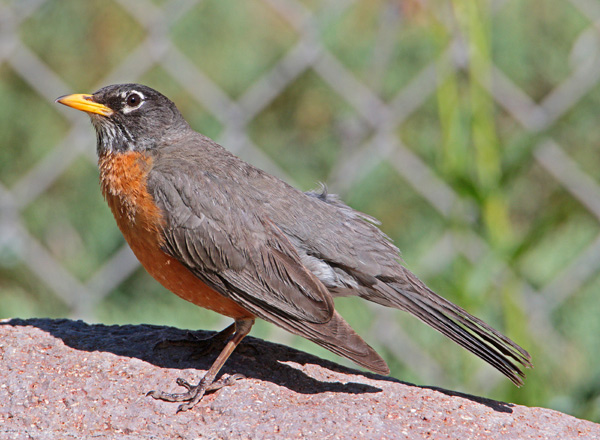
American Robin
by Jim Bruce
©Jim Bruce |
|
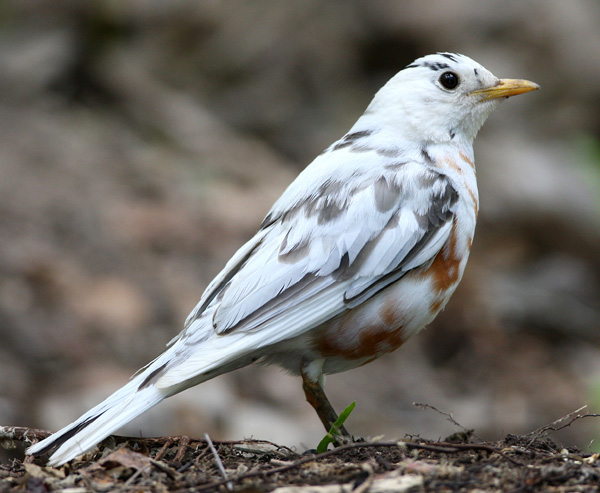
Albino (leucistic) American Robin
by Jack Binch
©Jack Binch |
Something I am working on this year is GISS or JIZZ, meaning identifying the
bird initially by 'general impression of size and shape'. Was it the size of a
robin? Did it fly like a robin, sound like a robin, did it look like a robin? It
was probably a robin. If you don't know what a robin flies like or sounds like,
you look for the brown back and red breast. If you don't know that a robin is
brown and red then you take it one bird at a time and start with the colors.
Soon you are able to know that a robin is different than a dove or a starling.
You know that a robin is smaller than a dove and bigger than a starling. You
know that a robin sounds different than a dove or a starling, it flies
different, it does different things when it lands in a tree. Then you take this
beginning and use it on other familiar birds, maybe comparing them to a robin
for starters. You start to pay attention to the main song and call of the bird,
to the way it flies overhead, and from tree to tree. It does take time, and it
takes patience!
I keep my Sibley and NatGeo field guides handy and refer to them often, and I
use the Peterson app on my phone. I also like Pete Dunne's Essential Field Guide
Companion, Kenn Kaufman's Field Guide to Advanced Birding, and The Crossley ID
Guides. These books go beyond the visual of the bird, and helps me get a better
understanding of what a bird does during different times of the year, or the day
even. They give more detailed habitat, migration and nesting information. They
have multiple photos or drawings, showing the bird at different angles or in
different molts. Pete Dunne's book doesn't have pictures, just very detailed
information that is easy to read and understand. I've been accused of reading my
field guides more than my scriptures...you probably have too!
Last year I spent more time birding alone that I have in a long time. It was
good and bad. Good because I tried harder, and bad because I'm not as good as
I'd like to be. I think the biggest boost to learning more is going out as much
as possible. Seeing, observing, making notes or taking photos, whatever helps
you the most.
Read Yvonne's article below, maybe we raise the bar and hit 2021 just as hard as
2020 hit us. (hehehe, I crack myself up..)
See you out there!
Machelle
,__,
(0,0)
/)_)
""
|
BIRD OF THE MONTH:
|
|
|
|
|
Pacific Loon
(Gavia pacifica)
by Kristin
Telford
|
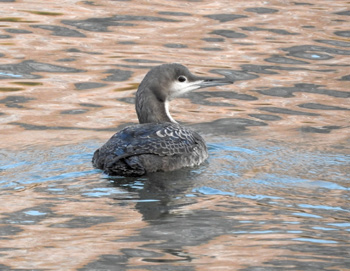
Pacific Loon
by Nichole Telford ©Nichole
Telford |
2020 was a year I didn’t get out
birding as much as some other years. Besides taking care of my school age
children, I also had a baby that required a lot of attention. So beyond what I
could see while on walks with the stroller or from the van, I didn’t see a
lot. That being said, I still got some lifers that year.
Up until 2020, I had only seen common loons before, so I
enjoyed the opportunity to see both a Yellow-billed loon (or two) and a
Pacific loon that year, thanks to my husband who made sure I got out to see
them… with the baby.
Loons are in the family Gaviidae. Of the loons I’ve seen,
common loons (Gavia immer) are the most common in Utah, with Pacific
loons (Gavia pacifica) being less common and Yellow-billed loons (Gavia
adamsii) being the least common.
Since I got a pretty good look at a Pacific loon last year,
I’d like to talk a little bit about it. For those that have seen common loons
here in Utah, the Pacific loon is smaller overall but specifically with a
smaller head and daintier bill proportionate to its body. Common loons can be
found all over North America (hence the name) but Pacific loons like to stay
more in coastal areas and will nest far to the North. They like to spend their
time in the ocean but nest in freshwater lakes. Pacific loons will lay one or
two eggs in their nests and like grebes (which we also get several varieties
in Utah) will carry their young on their backs when the babies are very young.
Pacific loons are diving birds (and sometimes at the
inconvenient time of when you want to take a picture) and can stay under water
for quite some time (also inconvenient when you want to take a picture). They
will dive to catch mostly fish to eat, though they will eat other things such
as insects and even some plant matter from time to time. Like some other
birds, they will also swallow pebbles to help grind the food they eat.
I’m glad I got to see a Pacific loon in Utah last year. It
is a beautiful bird and I enjoyed getting to learn a little more about it
other than just what it looked like.
References: National Geographic Field Guide to the
Birds of North America, Sixth Edition.
Allaboutbirds.org
Alaska Department of Fish & Game website (https://www.adfg.alaska.gov/static/education/wns/loons.pdf)
Photo credit: Nichole Telford
|
Special Articles:
|
|
DON'T BE A 'SLACKER' IN THE ODD NUMBERED YEARS!!
by Yvonne Carter
During
our fun Virtual Meeting in January, as we reviewed our accomplishments
participating in the 2020 Challenge, we started to talk about personal
challenges during 2021 since it is an 'odd' numbered year. I have been guilty
of being one of those 'odd-year slackers' so named. As I thought about the
situation during the Covid restrictions in 2020, why not step up to a new year
and change this bad habit I have had of being that 'slacker'.
|
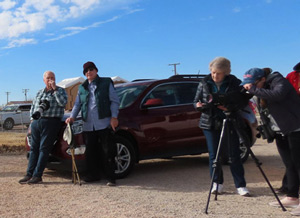
At Gunnison Bend Reservoir
|
I have thought of making the challenge to match 2021. For instance, why not 21
species in 21 counties, or 21 species on 21 reservoirs or lakes, etc. This
could be carried right through the challenge list we had. I felt the challenge
we had for 2020 was excellent because it pushed me into new areas in the state,
which I think some of you mentioned as we 'virtually' reviewed the year. There
were areas I had never birded at before.
A couple of weeks ago, I was thinking of ideas which have been shared in the
past by well-experienced birders that I have had the chance to go birding with.
One idea which would have to be accomplished perhaps through a couple of years
at least is to complete a list of minimum 100 species in each of the 29 counties
in Utah. Now, there is something to really accomplish.
21 new species in our Utah county, or perhaps the state. Or 21 new areas or
hotspots in the state you haven't visited in our beautiful state. Or ask
yourself, "Is there something I should be learning to do while birding that I
keep putting off?" For instance, I keep putting off learning how to attach
photos I have taken with my camera to a list I am submitting to Ebird.
It's a new year and hopefully we can soon be birding together. But at the
same time, get rid of old habits and try some new ideas!!
|
|

Gunnison Bend Reservoir, Delta, Utah
|
|
|
|
|
Utah County
Birders
The
2020 Birding Challenge
Congratulations
to all those who participated in the 2020 birding challenge! Here are
pictures of a few of the birders who were able to join us to pick up their
certificates and prizes. If we missed you, feel free to share a picture of
you with your certificate on our facebook page. Thanks for another great
challenge year!
List of Challege Award Winners
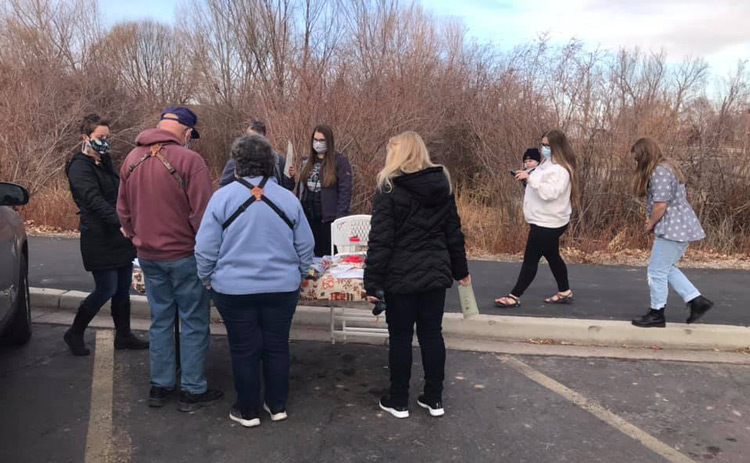
|
|
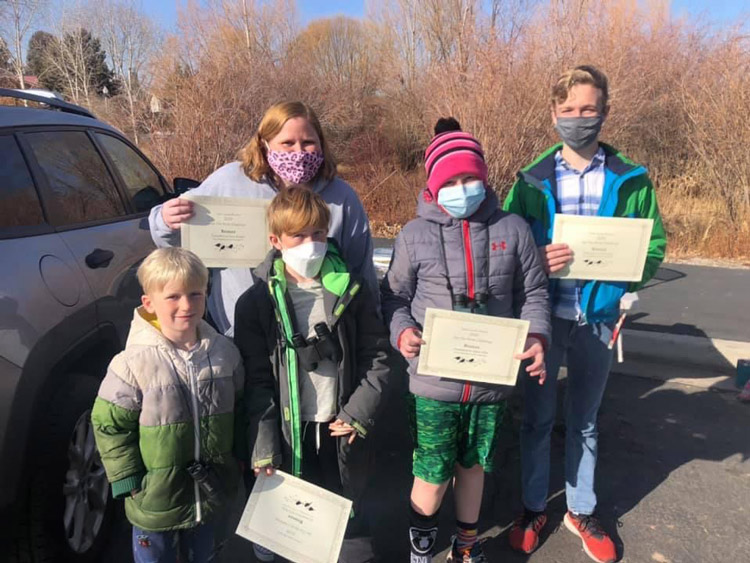
Katy Knight and her nephews: Sammy, Milo, Asher, Van!
|
|
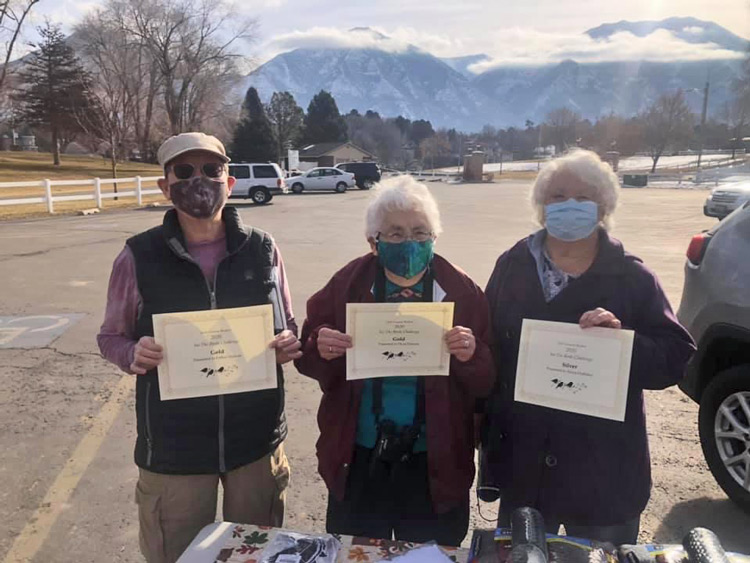
Esther Duncan, Flora Duncan, Alona Huffaker
|
|
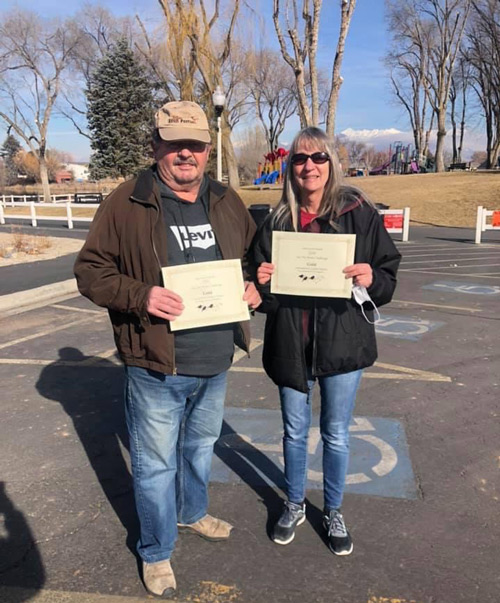 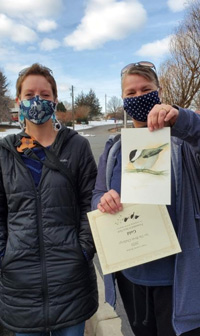
Danny and Linda
Nelson
Keeli Marvel, Suzi Holt
|
|
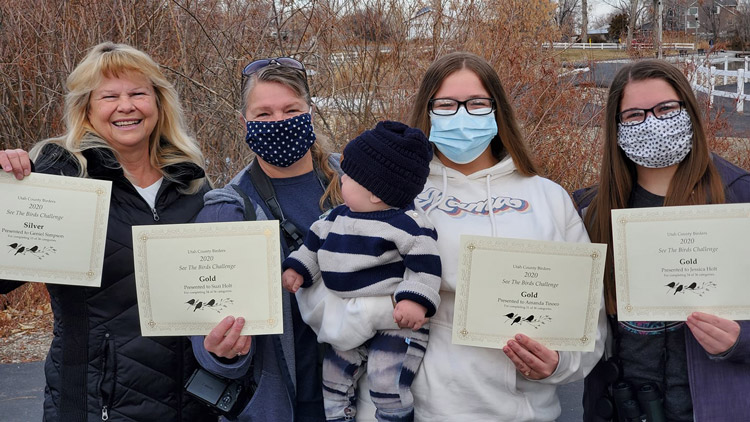 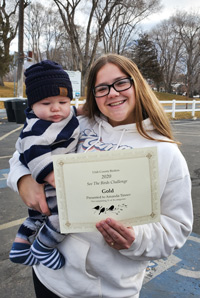
Geniel Simpson, Suzi Holt, Tatum Tinoco, Amanda Tinoco, Jessica Holt -
Tatum and Amanda Tinoco
We are missing mom but such a fun 2020 challenge!! We went for gold and got it
and had a blast! |
|
|
|
|
|
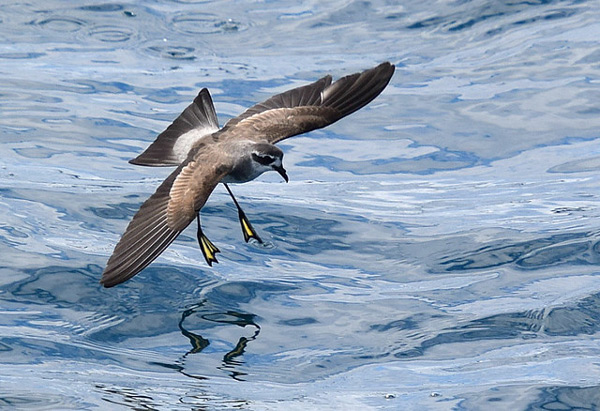
White-faced Storm-Petrel - New Zealand |
World Travelers contribute...
Nine New Species in the Photo Gallery
taken by Joel Beyer
Nine new species of birds have been
added to our Photo Gallery of US and Canadian Birds.
Most of these birds are very rare in North America but
Joel & Kathy Beyer have traveled to many parts of the world where
these birds are easier to find and photograph.
A lot of the photos were taken in different parts of
Thailand, and one in relatively nearby Malaysia. But others were taken in New
Zealand in the Southern Hemisphere, Colombia in South America, Spain in Europe
and one was taken in "nearby" North Carolina. You can click on the
links to see the pictures of the birds -- it's an easy way to take a birding
trip around the world!
White-faced Storm-Petrel taken on a Hauraki Gulf pelagic
tour in New Zealand
Stygian Owl at Rio Blanco Reserve in Colombia
Northern Boobook at Kaeng Krachan National Park in
Thailand
Spotted Flycatcher at the Ebro Delta in Spain
Red-flanked Bluetail (male - & female)
Red-flanked Bluetail at Doi Lang National Park in Thailand
Taiga Flycatcher also at Khao Yai National Park in
Thailand
Common Hill Myna Sepilok Rainforest Discovery Center, Sabah,
Borneo, Malaysia
Eastern Yellow Wagtail Rangsit Marsh, Thailand
Citrine Wagtail (male & female) at
Bancsolai rice paddy, Thailand
Bachman's Sparrow at Croatan
National Forest, North Carolina
Thanks to Kathy and Joel for sharing these rare bird
photos!
|
|
|
|
|
|
Field Trip Reports
(There are Individual Field Trip Reports on our
Facebook Page)
|
|
|
Payson Christmas Bird Count Report
((2
Jan 2021)
by Bryan Shirley
The Payson Bird Count was a great success this year.
We ended up with 91 species tying our all time high and smashing last year's
count of 84 species. We had 2 species never recorded before -
Cackling Goose
and
Chipping Sparrow.
Also had a record 5
Say's Phoebe
- probably due to the mild winter. Thanks again to everybody that
participated!
|
|
|
|
|
|
|
|
|
|
If you have had any interesting
field trips on your own this month,
feel free to write a report for the newsletter!
(Send it to:
ucbirders@utahbirds.org)
|
|
|














